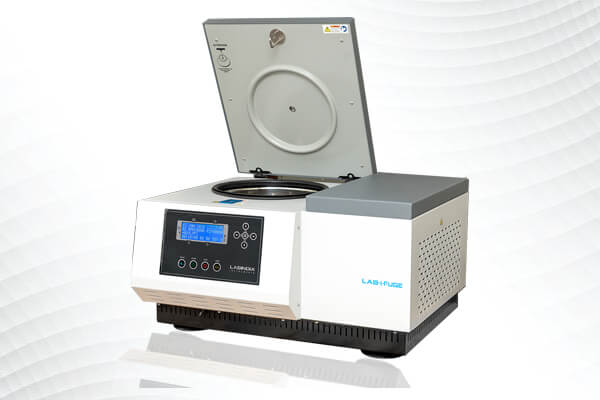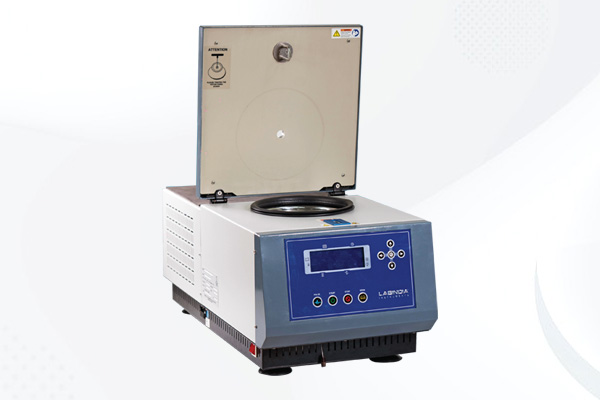Labindia announces the launch of the Centrifuge - "Lab-i-Fuge"
Centrifuge works by separating two materials based on different densities. They are best used to separate materials that have similar densities or when insoluble particulates are present in a dissolved solution
It is one of the necessary lab instruments which is widely used in all kinds of laboratories like research institutes, pharmaceuticals, hospital, and university.
Some common applications for centrifuges are listed below:
- Separation of mixtures with close densities
- Separate immiscible liquids
- Sediment suspended solids
- Separation of blood components
- Separation insoluble particles (e.g. insoluble proteins in a protein solution)
- Isotope Separation
- Gravity simulation environments for astronauts
- Separating creams
- Spin Column function
- Separation of wastewater sludge
- Material synthesis in a high gravity environment etc.
There are many types of centrifuge available in the market today, of which the two main factors are rotor speed and centrifuge size.
Labindia is a laboratory centrifuge manufacturer and supplier in India. The product description will help you to get the overview of the LAB-i-FUGE and the features of the product which makes best in their segment. Labindia LAB-i-FUGE (Refrigerated/Non Refrigerated) is bench top centrifuge with a high speed.
Before performing any activity, users can set up the separation process in the LAB-i-FUGE system in advance as per their requirement. This has been designed with the features of pre-set data in which you can set 99 different programs so when you are ready for the work, you are just a few clicks away, because you have already pre-set the program in the instrument.
To perform the activity on the LAB-i-FUGE machine, provide different types of rotors which can be set up at a variable speed and can go to a max of 20,000 RPM.for eg Fixed angle rotor, swing angle rotor. In a fixed angle rotor the rotor spins at 45- degree angle, in a Swing angle the rotor spins at a 90-degree angle.
Its ergonomic design helps working efficiently which ensures operator safety. While using the centrifuge machine, it is necessary to balance the rotor while spinning at a high speed. Placing the tube in the opposite directions keeps the centrifuge rotor gravity in the centre.
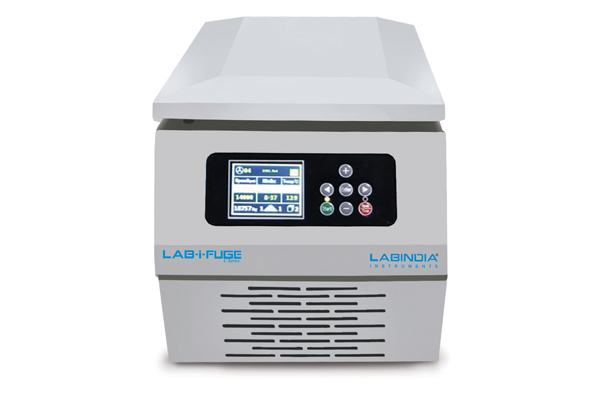
Table Top High Speed Refrigerated Centrifuge
LAB-i-FUGE C Series high speed refrigerated centrifuge is widely used in clinical medicine, biochemistry, genetic engineering, immunology, etc. It is an indispensable instrument for centrifugation at all levels of hospitals, research institutes, and universities.
Read More Request Quote
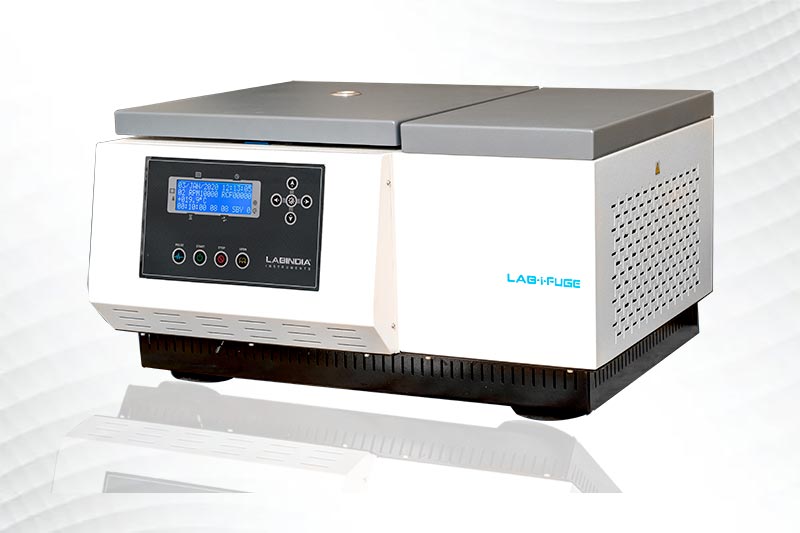
The Labindia Lab-i-fuge system delivers outstanding performance and reliability in the laboratory for centrifugation application. This innovative centrifuge offers exceptional quality for consistent result, unmatched productivity, versatility, performance and easy usage.
Read More Request Quote
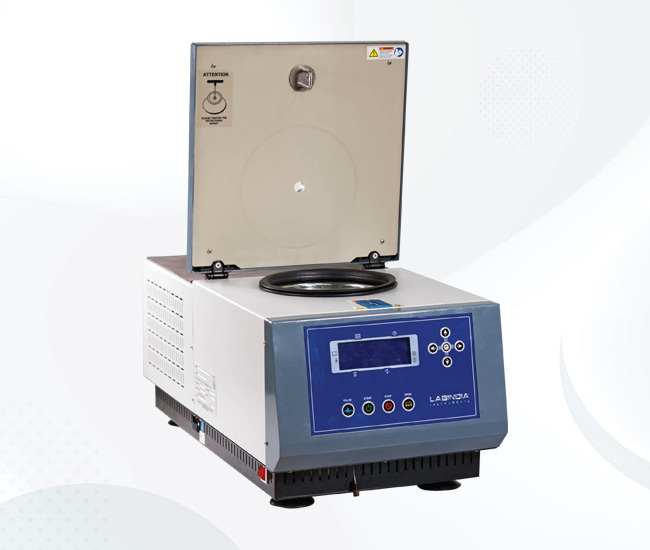
Lab i Spin is a Refrigerated bench top Centrifuge .It is Ideal for Hospitals , blood bank and covid testing Labs
Read More Request Quote
FAQs
Centrifugation is the technique of separating components where the centrifugal force/ acceleration causes the denser molecules to move towards the periphery while the less dense particles move to the centre.
Centrifugation is a technique used for the separation of particles from a solution according to their size, shape, density, viscosity of the medium and rotor speed.
- The process of centrifugation relies on the perpendicular force created when a sample is rotated about a fixed point.
- The rate of centrifugation is dependent on the size and density of the particles present in the solution.
Centrifugation uses a centrifuge, or a device that can rapidly spin, to speed up this process. Imagine we put the mixture into test tubes, and those tubes into the centrifuge. The centrifuge holds the top of the tubes, and the bottom is allowed to angle out. As it spins, the larger particles would get flung out farther, and smaller particles would stay close to the centre.
Centrifugation techniques take a central position in modern biochemical, cellular and molecular biological studies. Depending on the particular application, centrifuges differ in their overall design and size.
Many different types of centrifuges are commercially available including :
- large-capacity low-speed preparative centrifuges
- preparative high-speed ultracentrifuges
- refrigerated preparative centrifuges/ultracentrifuges
- analytical ultracentrifuges
- large-scale clinical centrifuges
- small-scale laboratory microfuges.
Relative centrifugal force is the measure of the strength of rotors of different types and sizes. This is the force exerted on the contents of the rotor as a result of the rotation.
RCF is the perpendicular force acting on the sample that is always relative to the gravity of the earth. The RCF of the different centrifuge can be used for the comparison of rotors, allowing the selection of the best centrifuge for a particular function. The formula to calculate the relative centrifugal force (RCF) can be written as:
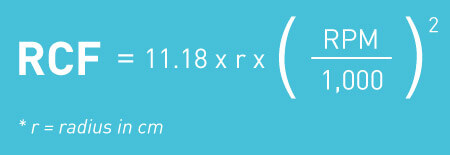
RCF (g Force) = 1.118 × 10-5 × r × (RPM) 2
Where r is the radius of the rotor (in centimetres), and RPM is the speed of the rotor in rotation per minute.
Revolutions per Minute (RPM) in regards to centrifugation is simply a measurement of how fast the centrifuge rotor does a full rotation in one minute. Centrifuges will have a speed range that they are capable of achieving and will vary depending on the centrifuge. A low speed centrifuge might spin at as low as 300 RPM, whilst a high speed centrifuge could spin up to 15000 RPM or even more. Ultracentrifuges are also available and are the most powerful type of centrifuge, they can spin in excess of 150,000 RPM.
Centrifuges are used in various laboratories to separate fluids, gases, or liquids based on density. In research and clinical laboratories, centrifuges are often used for cell, organelle, virus, protein, and nucleic acid purification.
There are two very common rotor designs :
- Fixed angle
- Swinging bucket
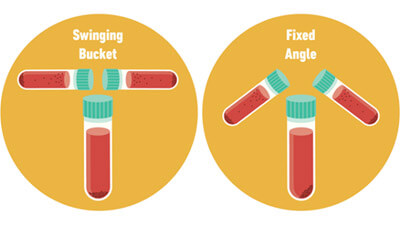
The fixed angle rotor is designed to hold tubes in a fixed position at a fixed angle relative to the vertical axis of rotation (up to about 45°). Centrifugation will cause particles to sediment along the side and bottom of the tube. Fixed angle rotors are ideal for pelleting applications either to remove particles from a suspension and discard the debris or to recover the pellet.
The swinging bucket design allows the tubes to swing out from a vertical resting position to become parallel to the horizontal during centrifugation. As a result, sediment will form along the bottom of the tube, swinging bucket rotors are best for separating large volume samples at low speeds and resolving samples in rate-zonal (density) gradients.
If you follow a given protocol, make sure to use the same type of rotor and apply the given relative centrifugal force (rcf or g × force) as well as the same temperature and running time. In general, the following major parameters have to be determined to achieve a successful centrifugation run:
- Type of sample
- Type of vessel
- Type of centrifuge
- Type of rotor
- Necessary relative centrifugal force
- Necessary temperature during centrifugation
It is essential to select a centrifuge that is suited to the specific application. When purchasing a centrifuge, it is important to consider the following questions:
- What sample volumes are you working with? For processes involving large or varying volumes, a floor-standing model with higher capacity and different rotor configurations may be the best solution.
- Are samples temperature sensitive? If so, a centrifuge with refrigeration and temperature control options is required.
- Will the centrifuge be used for processing clinical or blood banking samples? Cell washers or clinical models are available for these specific applications.
- How much laboratory space is available vs the centrifuge footprint?
- What is the maximum g-force the centrifuge is capable of generating? Low-speed centrifuges are ideal for separating whole cells, while ultracentrifuges are necessary for separating DNA and RNA.
To separate cellular and subcellular components, separating one cell type from another.
Removing cells or other suspended particles from their surrounding milieu on either a batch or a continuous-flow basis.
Isolating viruses and macromolecules, including DNA, RNA, proteins, and lipids or establishing physical parameters of these particles from their observed behaviour during centrifugation.
To study the effects of centrifugal forces on cells, developing embryos, and protozoa.

